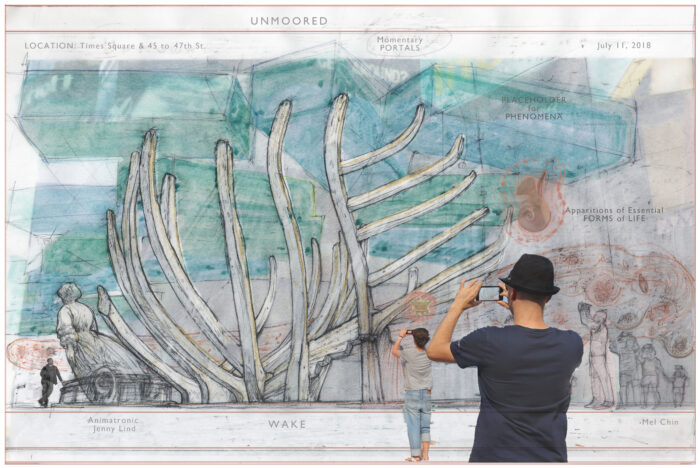
2018
Wood, steel, fiberglass, electronic and mechanical components, paint
24H x 34W x 60L feet
Exhibited in Times Square from July 11th to September 5th, 2018.
Co-presented by Times Square Arts, No Longer Empty, Queens Museum
Fabricated in partnership with University of North Carolina Asheville (UNCA).

Wake is a large-scale installation that evokes the hull of a ship crossed with the skeletal remains of a marine mammal. Parts of a shipwreck, modeled on the USS Nightingale, a nineteenth-century clipper ship, rise up from the plaza like the bleached bones of a massive beast. A 21-foot-tall carved sculpture of Jenny Lind, an opera star known as the “Swedish Nightingale,” accurately derived from a figurehead of the singer that was once mounted on the prow of the Nightingale, leads the wreckage. Subtle animatronic motions allow her to slowly breathe and scan the sky.
The physical construction of Wake took place at UNC Asheville’s STEAM Studio and was an interdisciplinary collaboration between students, faculty, staff and community artists all under the direction of Mel Chin Studio.
The artwork calls forth both the city’s triumphs and the complicated layers of its past. New York City has become a center of trade, commerce, finance, entertainment, and tourism, but also has a complex history that includes the shipping (by the USS Nightingale, among others) of guns and slaves that augmented this burgeoning city’s economy. The expanding past economies were a prologue to our current environmental dilemma. Jenny Lind, a Swedish opera singer from the same era, became the first American superstar when she toured the United States under the guidance of P.T. Barnum.

The physical presence of Wake serves as an entry point into Unmoored (link to unmoored), an ambitious twenty-first-century mixed-reality public art project that is interactive for all ages and backgrounds.
With Wake and Unmoored, Chin hopes to spark deeper personal investigations through digital devices and provoke enlightened stewardship of human actions in relation to global warming realities.